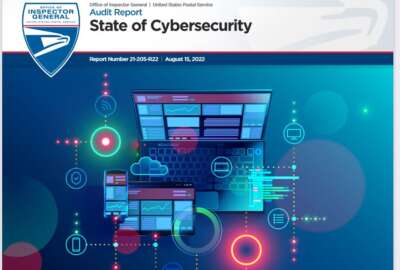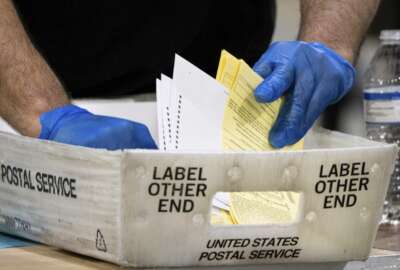
Hubbard Radio Washington DC, LLC. All rights reserved. This website is not intended for users located within the European Economic Area.
Hubbard Radio Washington DC, LLC. All rights reserved. This website is not intended for users located within the European Economic Area.
The Postal Service, like nearly every federal entity, has strict legal limits on how much executives can get paid. There are a few exceptions though.
Best listening experience is on Chrome, Firefox or Safari. Subscribe to Federal Drive’s daily audio interviews on Apple Podcasts or PodcastOne.
The Postal Service, like nearly every federal entity, has strict legal limits on how much executives can get paid. There are a few exceptions though. Each year the Postal Office of Inspector General does an audit to make sure the agency stays in compliance. With this year’s findings, the deputy assistant inspector general for finance and pricing, Alan MacMullin spoke to the Federal Drive with Tom Temin.
Interview transcript:
Tom Temin: Mr. MacMullin, good to have you on.
Alan MacMullin: Thanks. It’s great to be here.
Tom Temin: And this report is annual by statute or you just like to make sure you’re on top of it.
Alan MacMullin: Well, we just like to make sure that the Postal Service is on top of compensation to its executives. So this is actually a discretionary job, which we self initiate, generally speaking annually, but that can vary any given year based on certain priorities of our office.
Tom Temin: Has that ever been an issue in the past, where if there’s a bunch of people making way too much money?
Alan MacMullin: We have identified some issues previously in the past, but not so much as Postal Service employees making too much money, but some errors in some of the reporting that is required by the Postal Service to Congress on those limits.
Tom Temin: OK, so then tell us precisely what you were looking at in this current version, then?
Alan MacMullin: Sure, yeah. So there are two main sort of limits for executive compensation, the first being the executive, the executive schedule one. And so this is the system of salaries given to the highest rank, appointed government officials at the executive branch of the U.S. So that totals to about for calendar year 2021, this was about $221,000. So think of your cabinet level officials here your secretary of treasury, secretary of defense, those individuals are capped at approximately $221,000. In addition, there is a bonus exception. So these executives cannot exceed the salary of the vice president of the United States. So looking back at calendar year 2021, again, that was about $256,000. Now, also, the Postal Service is a little different. They do have, they are provided a critical position exception. So this gives them up to 12 officers or employees in critical senior executive positions, they may be paid a total annual compensation up to 120% of the vice president of the United States. So for calendar year 2021, this was about $307,000.
Tom Temin: That would be for example, if they had to hire someone from UPS or FedEx with logistics experience, and who might be making a whole lot of money, that would at least give them some incentive to do public service, basically?
Alan MacMullin: Exactly. This allows them to be more competitive in the market to that almost of the private sector.
Tom Temin: And so what did you find? Are they generally in compliance? And are they in compliance with the salaries and also the reporting that’s required?
Alan MacMullin: Yes, so we did not find any issues this year regarding compensation, the Postal Service complied with all applicable maximum compensation laws. We only identified some reporting issues during, during the year. So the Postal Service is required to report to Congress on any employees receiving compensation in excess of those limits. It’s included in their annual comprehensive statement of postal operations. This is their annual report to Congress. So compensation information required to be in that statement was in a couple of cases, incomplete and inaccurate.
Tom Temin: You had about 10 people from the roster of executives there that did not report. Were these substantial variances or what was the issue with those 10 people?
Alan MacMullin: I would not call them substantial variances. The total, if you kind of put it all together was was just over like $30,000 for bonuses that was excluded. And this is covering for all those employees, and then about 10,000 and their excess earnings that were reported there. This occurred primarily because the Postal Service did not include payroll adjustment data in that reported compensation information. And there was also a few clerical errors and typos as part of the reporting process that we found.
Tom Temin: We were speaking with Alan MacMullin. He’s deputy assistant inspector general for finance and pricing at the U.S. Postal Service. So I’m sniffing out a couple of possible recommendations here, then more on the administrative front than that they’re paying people a million dollars.
Alan MacMullin: Yeah. So I mean, basically, we recommended that their financial reporting team coordinate better with their payroll team to ensure any adjustments are incorporating. And so they’ve committed to establishing new reports that include those payroll adjustments so that they have that information come reporting time. We also asked them to basically look back at the process and see what they can do to prevent clerical errors and typos They, and there, they also agreed and committed to adding in some quality check reviews to the process, and they’re updating their standard operating procedures accordingly.
Tom Temin: And who has the discretion to do the bonuses to go higher if need be for the critical position exceptions and that kind of thing? Does that all go up to the postmaster general? Or to one of the governing bodies that seem to surround the Postal Service have a say?
Alan MacMullin: Yes, no, it’s actually the the Postal Service Board of Governors that will approve those bonuses for these employees.
Tom Temin: All right. So then what else do we need to know about this? I mean, it’s interesting that the salaries are similar to those in the executive branch, because every time you talk to a postal executive, the first thing they say is, we’re not a federal agency. But they really are. I mean, you guys really are, aren’t you?
Alan MacMullin: They do operate with very comparable to the federal government. And like you said, there’s only a couple of exceptions that they are provided to try to retain and recruit various executives in key positions. That’s a little more competitive with the private sector.
Tom Temin: And while we have you there’s a couple of annual financial reports coming from Postal Service to Congress in the next couple of months. What should we be watching for when those issued?
Alan MacMullin: Yeah, sure. So the Postal Service and in November we’ll be issuing its 10k. And this is a comprehensive report of its financial performance for the year. So this will have more detailed compensation information included, along with other information about its financial performance and operations. In addition, Postal Service will be issuing its, as the as mentioned annual report to Congress in December, for calendar year and fiscal year 2022.
Tom Temin: And from what we can discern some of the changes made statutorily and operationally under Louis DeJoy, the balance sheet looks like it’s not being gutted out so much for Postal Service looks like the basic finances are improving. Is that too early to predict that? Or do you think that’s what’s happening?
Alan MacMullin: Well, I think we will see in the 10k, that the Postal Service is in a different fiscal situation than it, than it has been previously. So definitely look forward to reviewing the financial information when it’s released and audited November.
Tom Temin: All right, and but you can’t buy stock anyway. And no matter what the footnotes say, but I also wanted to ask you one quick question on your job, you have pricing in your title. What does the IG look at with respect to pricing given that everything is a fixed statutory Board of Governors approved price that the Postal Service charges?
Alan MacMullin: So yeah, so actually, the Postal Service has been provided some more authority on its price, on its pricing for its products, but those are regulated by the Postal Regulatory Commission. So whenever any price changes take place, the Postal Service must submit information to the Postal Regulatory Commission, who provides advisory opinions on it. We as the cost and pricing directorate, we review various information that is provided to the PRC effectively so we can provide some assurance that the information that Postal Service is providing to the regulatory body can be relied upon.
Tom Temin: All right, well, we’ll watch out for those price increases and ask you whether they’re making a good justification. Alan MacMullin is deputy assistant inspector general for finance and pricing at the U.S. Postal Service. Thanks so much for joining me.
Alan MacMullin: Thank you. Appreciate it. Good to be here.
Copyright © 2024 Federal News Network. All rights reserved. This website is not intended for users located within the European Economic Area.
Tom Temin is host of the Federal Drive and has been providing insight on federal technology and management issues for more than 30 years.
Follow @tteminWFED

